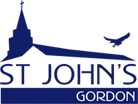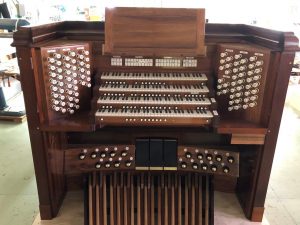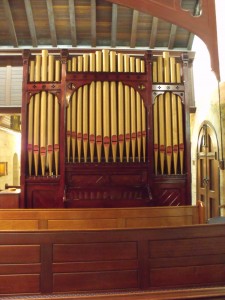Organs
For additional photos, please visit the Our New Organ Gallery Page
Main Organ
The new organ at S.t John’s Anglican Church, Gordon was built by the South Island Organ Company (New Zealand) and Stage 1 (chancel section) was completed in 2019.
Stage 1 comprises 2,056 individual pipes ranging in length from 5 metres to just a few centimetres. These are arranged in 31 ranks (or sets) of pipes. This means it is not a large organ . In fact, the North Shore includes larger instruments at North Sydney, Pymble and Lindfield; but the clever design of the St. John’s organ enables musical flexibility and gives the feel and sound of a much larger instrument than it really is. This effect is achieved with organ building techniques called extensions and duplications, resulting in an instrument of four manuals (keyboards) and 55 sounding stops. This enables it to play both traditional parish music in addition to some of the more complicated examples of choral accompaniment and organ repertoire.
The new South Island Organ Company organ at St. John’s uses mostly historic pipework made by organ builders Norman & Beard, and the later Hill, Norman & Beard between 1907 and 1935, but there is one rank of new pipes which is a copy of contemporaneous pipes. Twelve pipes were retained from the previous St. John’s organ.
The organ has fourteen separate chests (that house the pipes and supply them their air), and five reservoirs (that keep the air under various pressures). The blower (wind-providing motor) is housed outside the church building and is capable of providing 12 horse-power of energy.
The organ includes a number of elements that are firsts for Sydney, or are very rare. These include:
- Pedal cornet stop (a first in Sydney)
- An “undulating” flute stop (a first in Sydney)
- keyboard sustains (a first in Australia)
- embroideries on the organ façade (a first in Australia)
- a mobile console on the “stage” at the front of the building with good sight and sound lines
- a strong Tuba stop (one of 4 classical organs in Sydney that have these)
- a zimbelstern (bell star; one of 4 in Sydney)
- a glockenspiel (one of 3 on classical organs in Sydney)
- 4 keyboards (only the second 4-keyboard organ on the North Shore and one of only 4 in Sydney; additionally there are two 5 manual organs in Sydney)
- It is the largest inter-war symphonic-styled instrument in Sydney.
While none of these elements is new to organ building (J.S. Bach specified use of a Glockenspiel stop over 330 years ago), we have been fortunate to have the opportunity to combine so many exciting elements at St. John’s. The organ has drawn interest from the community; for example, Trinity College of Music (London) and the Organ Music Society of Sydney are already scheduled to visit.
The new organ provides many sound colours to enhance the liturgy of St. John’s, underline the meaning of Biblical and liturgical texts that are sung, provide authentic performance of choral and organ repertoire and musically excite worshippers and visitors to St. John’s for years to come.
Chancel Organ
This organ was ordered in January 1882 by William R. Angus, a well-known amateur organist, of the carriage and coach building form of Angus & Son, which was then at 101-185 Castlereagh Street, Sydney. William Angus was organist at the York Street Wesleyan Centenary Chapel in about 1881 and then at All Saints’ Anglican Church in Petersham in about 1900.
In 1940 Arncliffe Methodist Church acquired the organ. At union in 1977 when the Uniting Church was formed, many church properties from the former Methodist Church of Australasia, the Presbyterian Church or Australia and the Congregational Union became surplus to requirements and some were sold. This happened to Arncliffe Methodist Church which was acquired by the Coptic Orthodox Church and became St. Mark’s Cathedral, with the foundation stone laid by the Coptic Orthodox Pope on 8 May 1980.
No longer required by the Coptic Orthodox Cathedral, the Hill organ was moved to St. John’s Lutheran Church in Wollongong in 1979. In Wollongong it was restored and installed by Brown and Arkley, and has been maintained by Peter D.G. Jewkes Pty Ltd for some years now. After several years of searching and inspection of several instruments, the Hill chamber organ became available and was purchased in February 2012 by the St. John’s Music Association for use at Gordon.
The organ was Hill & Son job number 1810, and has a “deal case” with non-speaking front case pipes. These were originally diapered in typical Victorian fashion, but at some stage the ears of the case pipes were roughly removed and the pipes painted gold with red mouths. It would be wonderful to restore the pipes and diapering at some stage in the future. Likewise, the timber panels that encased the lower section of the rear of the organ and the upper rear sides to the sides of the swell box were at some stage removed, and as the organ is free standing again, these would be usefully reinstated. These panels give some hint as to the instrument’s provenance as a house organ. Likewise, the flue stops lack the forthright tone often associated with Hill organs, but the reed is fiery and much stronger than typical oboe stops. All manual stops are enclosed in a swell box operated by a hitch-down swell pedal. This box is very effective and helps give the impression that the organ has more stops than it in fact has, offering a very gradual decrescendo with judicious use of stops and swell.
Despite the organ’s diminutive size, it bears all the hallmarks of many of Hill’s larger and better-known instruments. The key cheeks are typical, the pipe mouths are typical, and the solidity and complexity of the mechanism was attested in the amount of time taken for the organ’s reassembly at Gordon. The pipework is voiced with the skill expected of its maker. The Dulciana is beautiful and with the swell box closed reduces to an almost inaudible pianissimo. This can be accompanied by the uncoupled pedal bourdon which speaks so beautifully as to render the absence of a coupled 8’ stop irrelevant. The Harmonic Flute as the solitary 4’ stop rather than a principal is perhaps another hint of the organ’s first home, but is a delightful stop characteristic of the maker.
At some stage amateur builders tried to install a super octave coupler and tremulant using parts from a reed organ. These have now been removed, restoring the organ to its original specification. The compass is 54/25, the two octave flat and parallel pedalboard sitting in a different place to most in relation to the manual. There are two composition pedals.
It has the following specification.
Manual:
Open Diapason 8’
Dulciana 8’
Lieblich Gedact 8’
Harmonic Flute 4’
Oboe 8’
Pedal:
Bourdon 16’
Manual to Pedal
For further details, see https://sydneyorgan.com/GordonAng.html
- Removed in 2019 to make room for a new organ from SIOC/HNB organ which was installed late 2019.
- Built in 1928-9 by W.G. Rendall.
- Rebuilt in 1930 by C.W. Leggo.
- Rebuilt and enlarged in 1956 S.T. Noad & Son.
- Rebuilt and enlarged in 1972 by A. Welby.
- Some electrical work with new console by Peter D.G. Jewkes in 1986.
2 manuals, 19 speaking stops, 7 couplers, electro-pneumatic action.
Great: Swell: Pedal:
Open Diapason No. I 8’ Horn Diapason (prep. for) 8’ Violone A 16’
Open Diapason No. II A 8’ Lieblich Gedact 8’ Bourdon B 16’
Claribel 8’ Salicional 8’ Principal A 8’
Dulciana 8’ Voix Celeste (prep. for) 8’ Bass Flute B 8’
Principal 4’ Principal 4’ Choral Bass A 4’
Lieblich Flute 4’ Piccolo 2’ Posaune (prep. for) 16’
Twelfth (labelled Larigot) 2-2/3’ Mixture (15, 19, 22) III Swell to Pedal
Fifteenth A 2’ Contra Oboe (prep. for) 16’ Great to Pedal
Mixture (prep. for) (22, 26, 29) III Trompette 8’ Great & Pedal Pistons
Swell to Great Tremulant
Super Octave
Unison Off
Sub-Octave
Capture action:
- 4 pistons to Great Organ
- 4 pistons to Swell Organ
- 4 toe studs to Pedal Organ
- Great to Pedal reversible piston (under Great manual)
- Swell to Great reversible piston (under Swell manual)
- Great to Pedal reversible toe stud
- Swell to Pedal reversible toe stud
- General Cancel piston
- Setter piston
- Two levels of memory
- Great and Pedal pistons coupler
For further details, see https://sydneyorgan.com/GordonAng.html
Gallery Organ
Built by father and son parishioners originally for their home, this amateur-built instrument was placed at the north end of the gallery when they moved to the country, and by 1989 had been donated to the parish. It comprised mechanical components from a 1933 Leggo organ from St Joseph’s Convent, Lochinvar and ordered from Laukhuff in Germany, and pipework acquired from Arthur Jones of Walkers organ builders, the old (replaced) Regal rank from the Pogson organ at The King’s School, and three ranks from the 1940 Leggo organ formerly at Manly Masonic Temple (Gemshorn, Principal and one of the Gedacts). This organ was used for worship when the Rendall organ was out of action during the installation of its new console in 1986, but earned more fame when used in music for two organs with the Rendall in concerts by Graham and Enid Anderson in 1993. Constant unreliability plagued the gallery organ, and despite attempts by the donors to repair it, recommendations were adopted to remove it in 2001. It returned to the original owners’ home where it remained until after the father’s death and sale of the home. It moved briefly to another private home but was never installed and has since been broken up. Its last known specification was as below.
Great: Swell: Pedal:
Open Diapason 8’ Gedact 8’ Bourdon 16’
Dulciana 8’ Voix Celeste 8’ Great to Pedal
Gedact 8’ Gemshorn 4’ Swell to Pedal
Principal 4’ Harmonic Flute 4’
Swell to Great Fifteenth 2’
Regal 8’
Mechanical key action






